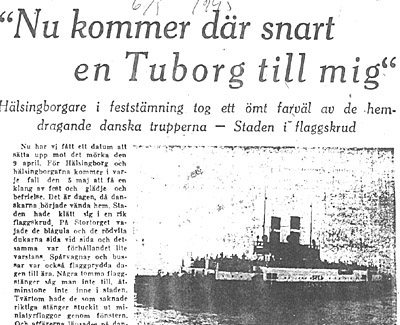| Befrielsen - Sverige

| | ”Kommer der ikke snart en Tuborg til mig” er en populær dansk drikkevise, som Helsingborgs Dagblad, den 6 maj 1945, citerede de første linier fra på sin forside. Der var feststemning! |
Befrielsesbudskabet skabte jubel i Helsingborg. Den danske Brigades ankomst og afrejse til Helsingør samt de mange civile flygtninges glæde over at kunne komme hjem satte sit præg på Helsingborg.
Flygtningestrømmen
I krigens sidste tid øgedes flygtningestrømmen til Skåne betydeligt. Det skyldtes bl.a. Folke Bernadottes forhandlinger, som muliggjorde at mange fanger fra koncentrationslejrene kunne løslades og sendes til Sverige. Størstedelen af disse transporter passerede København og Malmö og de løsladte fanger blev anbragt i forskellige lejre i Skåne. Malmö og Helsingborg var mellemstationer og i Helsingborg blev Ramlösa brugt som gennemgangslejr. Kurstedet var selvsagt ikke tilstrækkeligt og derfor måtte man bruge alt hvad der kunne anvendes af skoler, industrilokaler og hoteller. 16 000 flygtninge ankom til Skåne på mindre end en måned. Det krævedes en omfattende organisation for at tage sig af alle flygtninge. Alle var nødt til at gennemgå sundheds- og sikkerhedskontrol. Alle skulle ha tøj og mad.
Flaget til tops for Danmark
”Nyheden at Danmark atter er frit fejres, i særdeleshed af alle helsingborgere, med den allerstørste glæde. For at vise vores glæde og som en hyldest til et frit Danmark må flaget i dag gå til tops på hver flagstang i Helsingborg.”
Disse ord kunne læses på ledersiden i Helsingborgs Dagblad den 5. maj 1945. Allerede aftenen før havde nyheden om Danmarks frihed nået Helsingør. Når den sidste færge afgik til Helsingborg om aftenen den 4. maj, stod helsingoranerne forsamlet på kajen og råbte: ”Hils dem derovre!”

Fredsbudskabet i Sverige | 
Helsingborgs Dagblad, 6. maj 1945 |
Tusinder af helsingborgere ved frihedsbål
Om aftenen den 5. maj var tusinder af mennesker forsamlet ved ”Fria bad”, nord for byens centrum. Et fakkeltog tændte et gigantisk frihedsbål på stranden. Man ville sende en frihedshilsen til Danmark. Adskillige gange under krigen var bål blevet tændt for at sende en hilsen til de okkuperede dansker. Nu ville man hilse freden på samme måde.
Tidligere på dagen havde hele byen fulgt avisernes opfordring om at hejse flaget og overalt så man svenske og danske flag. Tusinder af mennesker var samlet i havnen for at sige farvel til de første hjemvendende danske tropper, uddannede i Sverige. Det var startskuddet til en lang strøm af hjemvendende danskere. En taksigelsesgudstjeneste blev afholdt i Gustav Adolfs-kirken. Kirken var fyldt op til sidste plads.

Fredsgudstjenester |
Norges frihed også fejret i Ramlösa
Sammen med glæden over Danmarks befrielse ventede man nu også på Norges frihed. Da den så kom, var lykken fuldstændig, ikke mindst i Ramlösa-lejren, hvor mange nordmænd var indkvarteret. I lejren viste man også sin taknemmelighed overfor de politifolk i Helsingborg, som hele tiden trofast havde støttet flygtningene.
Også denne gang blev en fredsgudstjeneste afholdt i Gustav Adolfs-kirken ved den dynamiske og populære sognepræst Gunnar Stenberg.

Fest i Ramlösa |
Kæmpemæssig transportopgave
Ved krigens slutning befandt sig over 100 000 ikke-svenskere i Sverige. En del blev i landet men de fleste skulle transporteres hjem. En minutiøs planlægning blev igangsat. Alle kunne jo ikke rejse samtidigt, eller over den samme havn. Helsingborg, Malmö og Trelleborg blev efter krigen passeret af mange tusinder hjemvendende flygtninge. Således vendte bl.a. Bruno Kreisky hjem til Østrig og Willy Brandt til Vesttyskland.
Men det var ikke bare flygtninge der skulle hjem. Tyske soldater og russiske krigsfanger i Norge skulle også sendes gennem Sverige. I løbet af 1945 blev 122 000 soldater transporteret, og en stor del af de tyske soldater måtte passere Skåne. Også her var detaljeret planlægning påkrævet, ikke mindst af sikkerhedsmæssige grunde. Et tragisk kapitel udgjordes af de baltere, som blev tvunget ud af Sverige, da Sovjetunionen stillede krav om, at de som havde deltaget i krigen imod Sovjet, skulle udleveres. Dramatiske og tragiske scener udspilledes i Trelleborg, da balterne blev tvunget ombord på færgen til en usikker og mørk fremtid.
Göte Friberg hyldet
Få uger efter befrielsen kom socialminister Gustaf Möller til Helsingborg. Han skulle afsløre en mindesten og ved den efterfølgende middag på Grand Hotel hyldede han politikommissær Friberg, som en mand man kunne stole på. (Möller og Friberg fik modtog beggeen udmærkelse fra den danske frihedsbevægelse for deres indsats under krigen.) Da Danmark trængte til hjælp var der brug for pålidelige personer.
Möller fortalte under spisningen, at Sverige under krigenbl.a. havde besluttet at sende en million patroner til Danmark. Da man i Stockholm overvejede hvordan dette kunne gennemføres uden at tyskerne opdagede noget, blev svaret på ministerniveau: ”Det er såre simpelt, vi meddeler bare Friberg i Helsingborg.” Selvfølgelig blev transporten en succes. Möller erklærede også, at regeringen nu, bagefter, burde godkende ”alt det som er sket her i Helsingborg hvad gælder skjulte transporter til og fra Danmark”, og som regeringen ikke har kunnet eller nået at godkende.
Man kan godt spørge om samhørigheden nogensinde har været større i Øresundsregionen, end den var i maj måned år 1945.

Göte Friberg | 
Göte Friberg |
|